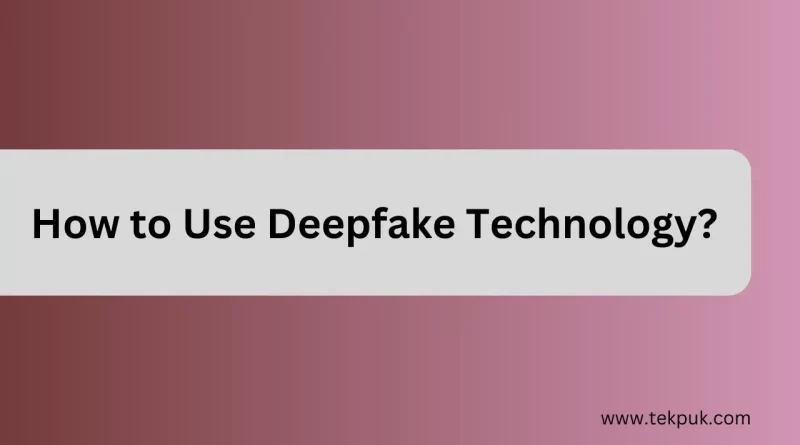How to Use Deepfake Technology
How to Use Deepfake Technology
The use of deepfake technology has gained a lot of attention in recent times. It is a powerful tool that allows individuals to create hyper-realistic, manipulated videos and audio recordings. In this article, we will delve into deepfake technology, exploring its history, uses, functionality, and the ethical considerations surrounding its use.
Deepfake technology, a portmanteau of “deep learning” and “fake,” is a fascinating, albeit controversial, technology. It involves using artificial intelligence (AI) to create convincing, often deceptive, media content. In this article, we will take a closer look at how to use deepfake technology.
What is Deepfake Technology?
Deepfake technology refers to using deep learning algorithms to manipulate or generate audio and video content that appears incredibly realistic. It leverages neural networks to replace one person’s likeness and voice with another, creating convincing impersonations.
The History of Deepfake Technology
Deepfake technology emerged in the mid-2010s, initially gaining attention for its ability to swap celebrity faces onto adult film actors. Since then, it has evolved to encompass various applications, both benign and malicious.
The Uses of Deepfake Technology
Deepfake technology has a wide range of applications, from entertainment to security. It can be used for fun, such as swapping faces in videos or creating realistic digital avatars. However, its potential for misuse is a significant concern, with implications for politics, security, and privacy.
How Does Deepfake Technology Work?
To create a deepfake, a deep learning algorithm analyzes a vast amount of data, including images and audio recordings of the target individual. The algorithm then maps the target’s facial expressions, voice, and gestures onto the desired content. The result is a video or audio clip that appears authentic.
Tools and Software for Creating Deepfakes
Several tools and software packages are available for creating deepfakes, making them accessible to a broad audience. Popular software like DeepFaceLab and FakeApp allows users to manipulate media content with relative ease.
The Ethical Implications of Deepfake Technology
The use of deepfake technology raises numerous ethical concerns, particularly privacy and misinformation. The ability to create convincing impersonations of individuals can be exploited for harmful purposes, leading to potential damage to reputations and privacy violations.
Deepfake Technology in Entertainment
In the entertainment industry, deepfake technology has been used for creating impressive visual effects and digitally resurrecting actors. It opens up exciting possibilities for film and television production.
Deepfake Technology in Politics
Deepfake technology can potentially disrupt the political landscape by creating misleading videos and audio recordings. Politicians can be falsely portrayed, leading to public distrust and confusion.
Deepfake Technology in Security
The security implications of deepfake technology are significant. Malicious actors can use deepfakes to impersonate individuals or manipulate audio and video evidence, potentially compromising security and trust.
Detecting deepfakes
Efforts to detect deepfake content are ongoing, with AI-driven tools being developed to identify manipulated media. The game of cat-and-mouse between creators and detectors is an ongoing one.
The Future of Deepfake Technology
As deepfake technology continues to evolve, it will likely become more sophisticated, requiring enhanced detection methods and ethical guidelines. The future of deepfakes is uncertain, but it holds both promise and peril.
You might find this interesting:
- Thinnest Android Phones of 2023
- Is Your Android Phone’s Screen Flickering?
- How to connect android phone to sceptre tv
- Steps to Connect HBO Max from Android Phone to TV
Conclusion
In conclusion, deepfake technology is a double-edged sword with the potential for creativity and deception. Understanding its uses, implications, and consequences is essential for navigating this evolving technological landscape.
FAQs
Q 1: Is deepfake technology illegal?
Ans. The legality of deepfake technology varies by jurisdiction. In many cases, it is not inherently illegal, but using it for fraudulent, harmful, or malicious purposes can result in legal consequences.
Q 2: Can deepfake technology be used for good?
Ans. Yes, deepfake technology has favourable applications in entertainment, visual effects, and other creative fields. However, its ethical use is a crucial consideration.
Q 3: How can individuals protect themselves from deepfake manipulation?
Ans. Individuals can protect themselves by being cautious about sharing personal data and media, using strong privacy settings on social media platforms, and staying informed about the risks of deepfake technology.
Q 4: Are there any regulations regarding deepfake technology?
Ans. Regulations regarding deepfake technology vary by region, and staying updated is crucial to ensure awareness of the local legal environment.
Q 5: What are the challenges of detecting deepfake videos?
Ans. Detecting deepfake videos is challenging due to their increasing sophistication. As technology evolves, detection methods must also advance to keep up with the manipulation techniques used by creators.




